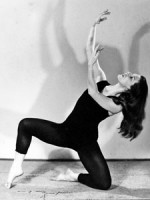Column Name
Title
Lorna Burdsall (’54, dance) wrote in her high-school yearbook that she hoped “to travel, write a book and then settle in the country.” It all came true, she wryly observed years later—“I didn’t say what country!”
Body
How a doctor’s daughter raised in New London, Conn., established modern dance in Cuba (and became at least tangentially involved in the revolution) is a story engagingly told in Burdsall’s self-published memoir, More Than Just a Footnote: Dancing From Connecticut to Revolutionary Cuba (2001). An illness made Burdsall unavailable for an interview, but her words from the book, quoted here, reveal a remarkable woman.
Her “very creative mother,” a lab technician who was also “an excellent character actress,” dressed up her daughters for photographs in handmade costumes. Young Lorna and her best friend would “traipse through the park” wearing Civil War costumes from the attic, “pretending we were living in the horse-and-buggy days.” Performances by visiting ballet companies and orchestras fueled her passion.
A self-described “immature, rebellious 17-year-old,” Burdsall spent a year at Green Mountain Junior College in Vermont before transferring to George Washington University, staying an extra year to earn a master’s in psychology. But there were no jobs without a doctorate, so she taught dance at William and Mary College in Virginia—where she first witnessed segregation. Burdsall choreographed for and danced in recitals, Restoration plays, even a documentary for RKO (Sweet Land of Liberty), but quit after her third year of teaching when she was not allowed to bring her white students to perform at a local black high school.
Abroad in 1953 for the first time at 25, Burdsall spent a month in Trinidad and Tobago with dancer/anthropologist Pearl Primus, who took 10 people to help her with research in exchange for African dance classes. Burdsall’s letters home reflect total immersion in an exotic experience that whetted her appetite for more Caribbean culture.
Back in New York, she took classes in Juilliard’s new Dance Division, whose faculty she knew from summers at the American Dance Festival in New London, and danced in revivals of works by Doris Humphrey at Juilliard.
At a Halloween festival at International House, Burdsall noticed a red-haired charmer dancing the mambo and “bet [a friend] a milkshake that the fellow was not Irish.” She won: he was a Cuban studying business administration at Columbia prior to taking over his family’s rum and beer distributing business. Two months later, Burdsall ran into Manuel Pineiro again and brought him to a friend’s party. Though neither fit the other’s expectations, the fascination and attraction deepened. They married secretly, and in the summer of 1955, she followed him to Cuba.
Burdsall was only dimly aware at first of her new husband’s involvement in the underground movement to overthrow Batista. As his stints in the mountains with Castro’s guerillas grew longer, she wandered the streets soaking up Cuban life (signing her letters home “Learning Lorna”) and taught dance classes. On a visit to her husband’s secret headquarters, Burdsall—dressed in linen and lace to deflect suspicion of rebel activity—arrived bedraggled and mud-spattered, to spend just a few hours with Manuel before his next mission. She awoke the next morning to find she had slept on a pile of grenades.
But the revolution Burdsall spearheaded was artistic. Cubans knew only ballet before her arrival (Alicia Alonso’s famous Ballet Nacional de Cuba); once Castro came to power in 1959 (with Pineiro serving as his chief of intelligence), the cultivating of Cuban culture took center stage. Burdsall taught at the National Dance School and was a founding member of Conjunto Nacional de Danza Moderna, which she eventually directed. The barely two-year-old company won acclaim on its first European tour in 1961. Burdsall was with the company (now Danza Contemporánea de Cuba) for nearly 20 years, and created numerous works reflecting the spirit of the Cuban people.
A humorous, 40-minute dance created in 1981 with a group of students in Burdsall’s living room (utilizing the army-surplus silk parachute that became her trademark) sparked the formation of a unique dance-image-theater company named after that first work: Así Somos (The Way We Are). Burdsall created avant-garde works that utilized props such as plastic barrels illuminated with flashlights for striking effects, and introduced roasted pumpkin seeds to her audience from baskets onstage (resulting in at least one magazine interview). Performing mostly in small venues, Así Somos even appeared at California’s Stanford University and at the Mexican Biennial. Burdsall’s granddaughter Gabriela—a dancer with Danza Contemporánea “who appears to be the very reincarnation of myself,” writes Burdsall—now runs Así Somos.
Last May, Burdsall (featured in John Anderson’s 1999 film, From Cuba With Love) was awarded the 2008 Cuban National Dance Prize. Now 80, she has mentored and inspired generations of dancers.





